Chapter 6: Pakistan's Support to
Terrorism
For the last about
five years, Pakistan has been waging a low intensity proxy war in Jammu
and Kashmir. Backed by official support from Pakistan there has been a
well-organized and consistent Pakistani plan to subvert the authority of
the Jammu and Kashmir Government, create chaos inspire terrorism, fan the
flames of disruption and secessionism, subvert the loyalties of the people,
kill and and kidnap, organize murders and mayhem, whip up communal passions,
raise the cry of "jehad" and open the floodgates of Islamic fundamentalism
with international linkages. A number of "Jehad Conferences", rallies and
demonstrations have been held in Pakistan and Pakistan-occupied Kashmir
to express solidarity with the Kashmir terrorists.
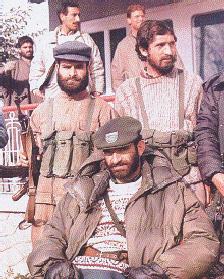
Terrorists leader with bodyguards.
The plans are hatched in Pakistan and executed
through Pakistani agents provocateur and such Kashmiri young men who have
been lured, bribed, trapped or coerced, motivated or misguided into becoming
militants. Pakistan Army Rangers and the Pakistan Inter-Services Intelligence (ISI) with its field units have been conducting and directing the programs
of subversion. Pakistan has been training and arming the militants, providing
funds, affording refuge and safe havens to the militants, as also setting
up rapid communication systems. Backing the militants is a well orchestrated
multi-media propaganda campaign with twin objectives: beamed to the militants
in the Kashmir Valley the purpose is to stoke the fires of militancy and
keep secessionism alive; in the international arena the intention is to
damage the image of India.
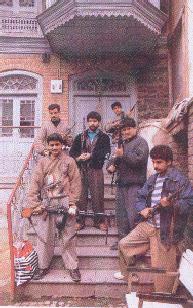
Well armed terrorists in Kashmir.
Kashmiri youth are taken surreptitiously across
the line of control to Pakistan occupied Kashmir and to Pakistan. There
they are trained for subversion, equipped with weapons as also indoctrinated.
Thereafter, they are infiltrated back into Jammu and Kashmir. The Pakistan
Army often provides covering fire for such infiltrators across the line
of control.
Before the newly-recruited militants are sent
to POK or Pakistan they are given code names to conceal their identity
or they are provided with fake identity cards to cover them up as government
employees. They are usually picked up in small batches from predetermined
places and escorted to the line of control on foot and thereon to some
transit camps.
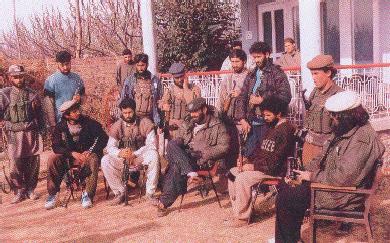
Terrorists at a hide-out in Kashmir.
In the transit Camps, motivational films are screened,
copies of the Holy Quran are distributed and religious and fanatical songs
with anti-India strains are sung. From the transit camps the recruits are
moved to the training centers. Usually they are taken blindfolded or in
fully covered trucks to make sure that they can neither identify the training
sites nor the roads leading to them.
Motivation is an essential part of the training.
Firebrand ulemas acting as coordinators and Mujahideen leaders are invited
to speak to the recruits exhorting them to jehad. On the conclusion of
the training the militants are returned to the transit camps. Once again
they travel blindfolded or in covered trucks. Each trainee is given assorted
weapons at the staging areas. Finally they are taken back to the line of
control. The Pakistan ISI guides help the militants in finding their way
through forests and mountain passes through which runs the line of control
from where they can be collected later.
TRAINING CAMPS
Nevertheless it is always hazardous crossing the
line of control. The militants are apprehended by the Indian security forces.
A number of them have been killed while crossing the line. Some of those
apprehended make confessions or provide revealing information under interrogation.
But still many sneak across the undulating thickly-forested terrain. To
train and indoctrinate the militants Pakistan has set up training centers
located in (rebel-held) Afghanistan close to the Pak-Afghan border. Over
105 such training camps - 48 in Pakistan, 49 in POK and eight on the Pak-
Afghan border - have come to the notice of Indian authorities. Pakistan
has been running more than 50 transit camps either in Pakistan itself or
in POK to hold the trainees before they are dispersed to various training
centers.
Training is imparted by Pakistani instructors
or by those of the Kashmiri militants who have graduated after intensive
training. The training covers subjects like subversion and sabotage use
of explosives, techniques of destroying vital installations like railway
lines, bridges, oil tankers, power houses etc. To toughen the militants
and give them "battle inoculation", some trainees are sent to the Pak-Afghanistan
border under the banner of Harkat-e- Mujahideen where they are made to
fight in simulated battle conditions. Some of the selected militants are
primed for a longer period and are intended to attain greater competence
in the methods of guerrilla warfare, laying of land mines, handling of
remote control devices with special emphasis on extensive use of improvised
explosive devises and wireless communication. Operating sensitive high-frequency
wireless communication sets is another item of specialized training.
The pattern of arms training has been changing.
Earlier the elementary training for seven to ten days included introduction
to AK-47 rifles, Chinese pistols, rocket launchers use of light machine
guns and explosives. Techniques of ambushing concealment reconnaissance
and intelligence gathering were also covered. Included in this program
was indoctrination for armed struggle. This was achieved through lectures
and video films.
Training at the centers is now handled entirely
by the Pakistan Army and the ISI. Multiple training programs, dovetailing
basic arms training with long duration specialized schedules, have been
organized. There are extended training courses of two to twelve weeks incorporating
the use of sophisticated heavy weapons including rocket launchers, MMG/LMG/AK-47/56/74,
sniper rifles, mortars, remote control devices anti-personnel and anti-tank
mines. The operation and control of high explosives, anti-aircraft guns,
heavy machine guns, etc., are also included in the schedule. Courses in
rock climbing mountaineering survival in jungles as also mock exercises
for border crossing including first aid and paramedical training are conducted.
Video cassette films on commando operations are screened at the training
centers. Simultaneously, the Pakistani army has been imparting wireless
communication training (Morse and computer-based data mode) for four to
twelve weeks to ensure that trained staff is available to maintain direct
links between the Kashmir militants and the Pakistan authorities.
ARMS SUPPLY: PROGRESSIVE INCREASE
Recently, the training schedule was further streamlined
and extended for selected groups from six months to a year. Selected young
militants are taken to Pakistan Army camps along the line of control where
they are trained for over six months through intensive firing exercises.
In some makeshift training camps inside Pakistan stress is laid on the
practical handling of explosive devices. Emphasis is now laid on achieving
tough physical standards and the development of leadership qualities. Educated
militant youth, preferably with scientific and technical background are
imparted specialized and prolonged training. The use of new weapons including
SVD Dragnov sniper rifles, 12.7 mm heavy machine guns and 82 mm mortars
is taught.
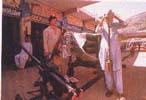 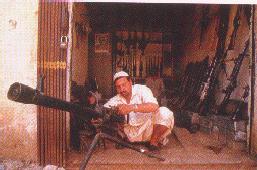
Arms Bazaar in Pakistan.
Pakistani-supplied arms and weapons seized every
now and then on the border and the line of control as also obtained from
the hideouts of militants provide tangible evidence of the Pakistan hand.
The seizure of weapons recorded year after year shows a progressive increase
in their supply. These arms are procured partly from Pakistan Army and
intelligence establishments; siphoned off from the supplies Pakistan received
for the Mujahideen in Afghanistan; and a few from the arms bazaars in the
North West Frontier Province.
Pakistan has been training thousands of Kashmiri
terrorists, supplying arms and ammunition to them, providing financial
assistance as also monetary inducements to the trainees. Couriers and guides
have been provided by Pakistan. Necessary support facilities like office
accommodation, telephones, wireless communications safe havens have also
been made available. This has been confirmed and cross checked with various
militants who have been captured by the Indian security forces.
The present situation in Kashmir has been created
by Pakistan's support to terrorism. This support to religion-based terrorism
is not only an attempt to unilaterally alter the status quo on the ground
but also to undermine India's secular fabric. Pakistan's denial of its
involvement is not convincing. In 1948 Pakistan denied that it was sending
tribals and armed people into Kashmir. The Security Council resolution
of August 1948 documented the Pakistan aggression when it stated: "The
presence of troops of Pakistan in the territory of the State of Jammu and
Kashmir constitutes a material change in the situation since it was represented
by the government of Pakistan before the Security Council. Pakistan had
then too asserted that disturbances in the valley were the result of an
internal uprising.
OVERWHELMING EVIDENCE
In 1965, Pakistan similarly denied that it had
sent armed infiltrators. The arson sabotage and killings by the infiltrators
were again attributed by Pakistan to internal uprising in Kashmir. It persisted
with this charade before the Security Council even though the UN Military
Observer Group for India and Pakistan and independent observers documented
that massive infiltration of armed personnel had taken place. Subsequently
the Pakistani leaders themselves boasted of having sent in the infiltrators.
Today Pakistan is once again denying involvement with terrorism. In the
face of the overwhelming evidence of overt and covert support, and the
history of Pakistan's past deceptions in this regard, there can be no genuine
takers for the Pakistani propaganda line.
| 


















No one has commented yet. Be the first!